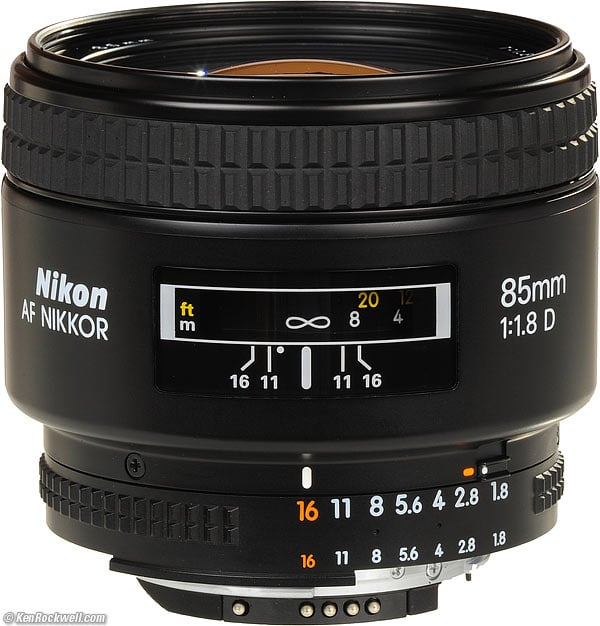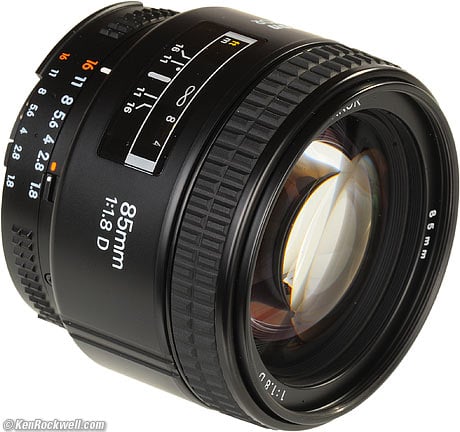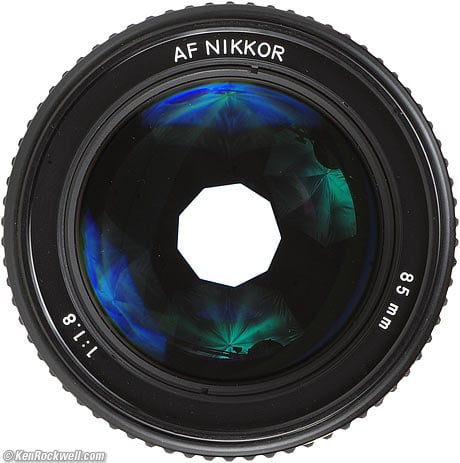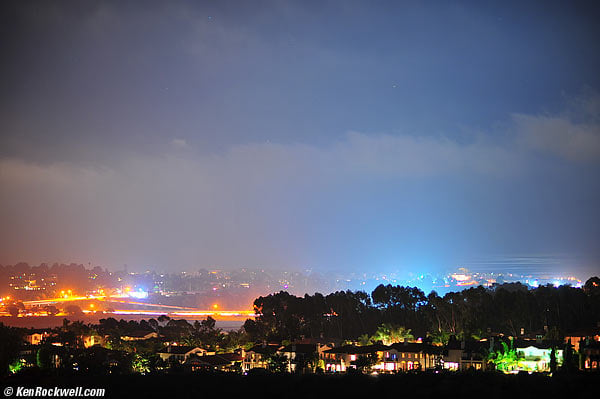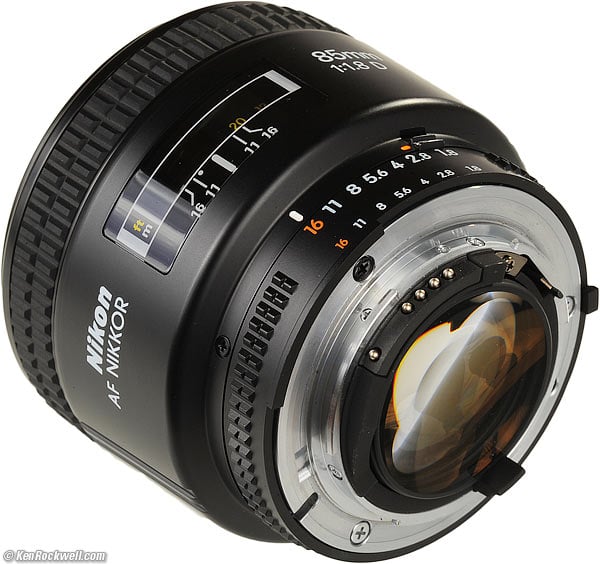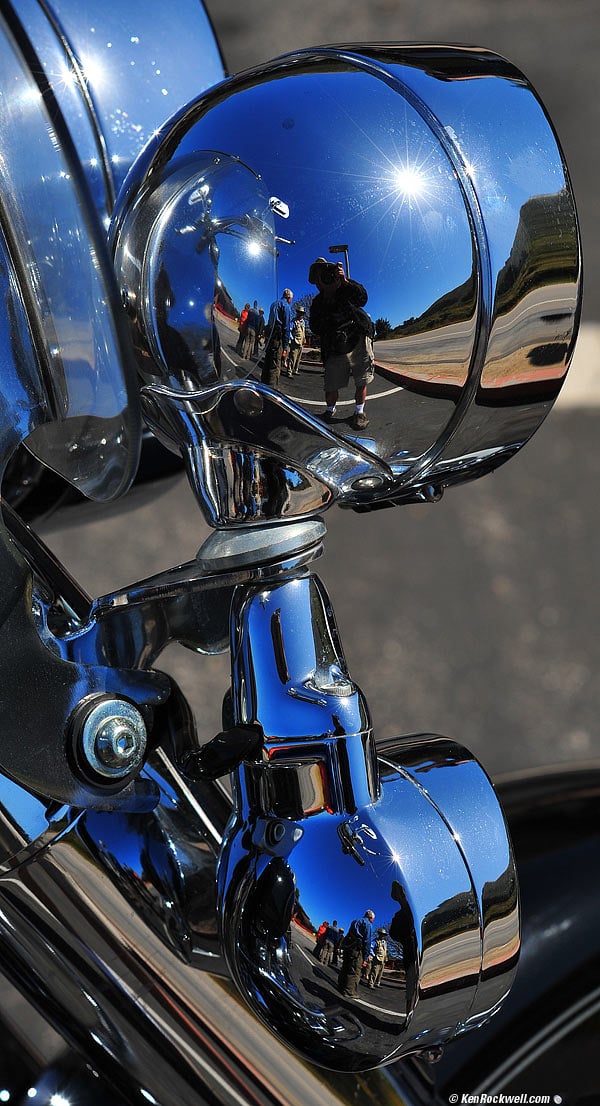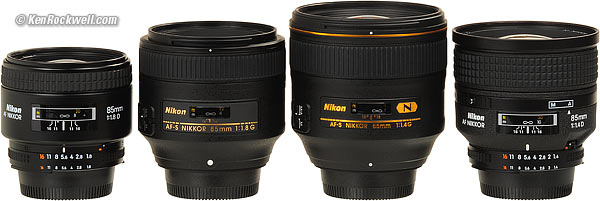Home Donate New Search Gallery Reviews How-To Books Links Workshops About Contact
Nikon 85mm f/1.8
AF and AF-D NIKKOR (1987-2018)
NEW: Nikon Z 85mm f/1.8 (2019-)
Intro Specifications Performance Compared Recommendations
Nikon AF Nikkor 85mm f/1.8D (metal 62mm filter threads, 12.9 oz./366g, 2.8'/0.85m close-focus, about $460 new or $350 used). enlarge. This free website's biggest source of support is when you use these links, especially this link directly to it at Adorama, at Amazon or used at this direct link to it at eBay (see How to Win at eBay), when you get anything, regardless of the country in which you live. Thanks! Ken.
April 2012 Nikon Reviews Nikon Lens Reviews Other Reviews
NEW: Nikon 85mm f/1.8 G: the new plastic consumer version for more money.
NEW: Nikon 50mm and 58mm Bokeh Comparisons.
Why Fixed Lenses Take Better Pictures
Nikon High-Speed 50mm Lens Sharpness Comparison 09 Sep 2010
Sample Images from California's Central Coast June 2010
85mm Lens Specifications Compared 23 June 2009
85mm Lens Central Sharpness Comparison 23 June 2009
85mm Lens Corner Sharpness Comparison 23 June 2009
| Optics: | |
| Mechanics: | |
| Ergonomics: | |
| Usefulness: | |
| Availability: | |
| Overall: |
Introduction top
Intro Specifications Performance Compared Recommendations
Compatibility History Production
|
Adorama pays top dollar for your used gear. I use Adorama, Amazon, eBay, Ritz, B&H, Calumet, J&R and ScanCafe. I can't vouch for ads below.
|
The Nikon 85mm f/1.8 AF and AF-D have superb optical and mechanical quality. They have been among Nikon's most popular lenses for many decades, and rightfully so.
They have superb performance, especially for use on the 36 MP Nikon D800.
As a rear-focus lens, nothing moves externally as it focuses except the focus ring. The all-metal filter ring stays put!
You always have to move the switch on your camera to switch between auto and manual focus. If you just want to grab the ring to focus at any time, get the newer, dinkier Nikon 85mm f/1.8 AF-S G.
I prefer this original lens to 2012's new plastic made-in-China G version. This original lens offers a better 9-bladed diaphragm, superior mechanical quality that will last a lifetime, isn't gelded so it works on every camera, has a hard infinity-focus stop, metal filter threads, faster autofocus and smaller size than the new G 85/1.8.
This is an FX lens, and works especially well with on FX, 35mm and DX Nikons like the D4, D800, D800E, D7000, D700, D3X, D300s and F6. It works fantastically on manual-focus cameras like the F2AS, F3, FE and FA, since it has real manual-focus and aperture rings that work exactly as they should.
The 85mm f/1.8 AF-D and AF works great with almost every film and digital Nikon camera made since 1977. If you have a coupling prong added to the diaphragm ring, it's perfect with every Nikon back to the original Nikon F of 1959.
The only incompatibility is that it will not autofocus with the cheapest D40, D40x, D60, D3000, D3100, D5000 or D5100, but if you focus manually, everything else works great. These cameras have in-finder focus confirmation dots to help you.
See Nikon Lens Compatibility for details on your camera. Read down the "AF, AF-D (screw)" column for this lens.
There are two almost identical version of this lens: the original AF version from the dawn of Nikon's autofocus made from 1987-1994, and today's AF-D version, made since 1994.
The only minor difference is the addition of the "D" feature which couples focused distance to the camera for exposure calculations, which only matters with flash. This review applies equally to either version.
The way to identify them is by the "D" on the newer lens (as "1:1.8 D" on the front and side, or by the little slide lock just above the aperture ring. The older AF lens is simply marked "1:1.8" and the little lock above the aperture ring is a better and more complex spring-loaded and rotating pushbutton affair.
Nikon has made over 300,000 of these lenses.
Nikon made over 100,000 of the original (1987-1994) AF version, and has made more then 225,000 of the current AF-D version — so far.
Nikon 85mm f/1.8 AF-D. enlarge.
Specifications top
Intro Specifications Performance Compared Recommendations
Name top
Nikon calls this the Nikon AF NIKKOR 85mm f/1.8 or f/1.8D RF.
NIKKOR: Nikon's brand name for their lenses.
D: Couples distance information to the Matrix Meter (from 1994).
RF: Rear focusing; nothing moves externally as focused except the rear element.
∅62: 62mm filter thread.
Optics top
6 elements in 6 groups.
Multicoated.
Rear focus; nothing moves except the rear element and focus ring as focused.
Diaphragm top
Front, Nikon 85mm f/1.8 AF-D. enlarge.
9 straight blades.
Stops down to f/16.
Coverage top
Focal Length top
85mm.
When used on a DX camera, it gives angles of view similar to what a 129mm lens gives when used on an FX or 35mm camera.
Angle of View top
28.5° diagonally on FX and RealRaw.
(18.8º on small-format DX.)
Close Focus top
2.8 feet (0.85 meters).
Maximum Reproduction Ratio top
1:9.2.
Hard Infinity Focus Stop? top
Yes.
This is great for astronomy; just turn to the stop and you have fixed laboratory-perfect focus all night.
Focus Scale top
Yes.
Depth-of-Field Scale top
Yes, for f/11 and f/16.
Infra-Red Focus Index top
Yes, white dot in depth-of-field scale.
Aperture Ring top
Yes.
Full-stop clicks.
Filter Thread top
62mm, solid metal.
Does not rotate or move, ever.
Size top
Nikon specifies 2.30" (58.5mm) extension from flange by 2.81 " (71.5mm) diameter.
Nikon specifies the earlier AF version as 71mm (2.80") diameter.
Weight top
The D version weighs 12.892 oz. (365.5g).
The earlier non-D AF version weighs 14.155 oz. (401.3g).
Nikon specifies 13.4 oz. (380g) for the current AF-D (1994-today) version.
Nikon specifies 14.6 oz. (415g) for the earlier AF version (1987-1994).
Hood top
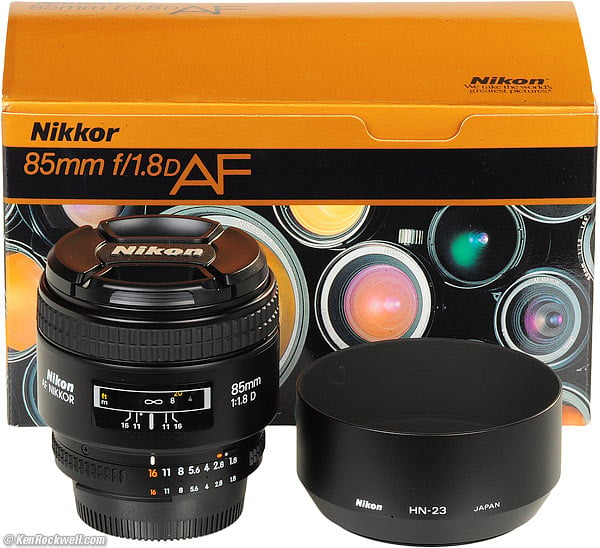
Nikon 85mm f/1.8 AF-D and included HN-23 metal hood.
HN-23 metal screw-in, included.
TC-200/201, which are manual-focus only.
TC-14A, which is also manual-focus only, and Nikon further warns that there can be some vignetting.
Quality top
Made in Japan.
Made in Thailand since 2010.
Nikon Product Number
1931.
Announced
December 1987.
AF-D version: March 1994.
Corrected for inflation, 2012* |
Dollars at the time* |
|
1988 |
$520 |
$270 |
1991 |
$450 |
$270 |
1992 |
$445 |
$275 |
1994 |
$475 |
$310 (after rebate) |
1995 |
$590 |
$395 |
1996 |
$490 |
$340 |
1997 |
$490/560** |
$345/395** |
1998 |
$420/500** |
$300/360** |
1999 |
$440/490** |
$325/360** |
2000 |
$435/505** |
$330/385** |
2005 |
$390/405** |
$335/350** |
2009 |
$475 |
$450 |
2012 |
* At full NYC discount. Very few people bought their lenses this inexpensively before 2005.
** Gray/USA.
Performance top
Intro Specifications Performance Compared Recommendations
Overall Autofocus Bokeh Color Coma Distortion
Ergonomics Eyeblow Falloff Filters Focus Breathing
Ghosts Hood Lateral Color Fringes Mechanics
Sharpness Spherochromatism Sunstars Survivability
Overall performance top
The Nikon 85mm f/1.8 AF and AF-D is among Nikon's best lenses of all time, as are most 85mm to 105mm lenses.
Autofocus performance top
Overall
Autofocus is fast and sure, however you must move a mechanical switch on your camera to swap between manual and autofocus.
AF Speed
Autofocus is fast, faster than the new 85mm f/1.8 G!
AF speed is super fast on every Nikon, even the old F100 and F5.
One full turn (two half-turns) of the AF screw pulls focus from infinity down to 16 feet on the original (1987-1994) AF version, and down to 12 feet on today's AF-D version (1994-today).
AF Accuracy
AF is always right on, especially on the 38 MP Nikon D800, and especially at f/1.8.
Manual Focus
Manual focus is perfect.
The metal internal-focus ring flicks with a fingertip.
Bokeh performance top
Bokeh, the character of out of focus backgrounds, not simply how far out of focus they are, is good enough. If you want out-of-this world bokeh, get the Nikon 85mm f/1.4 AF-S G.
Spherochromatism will also affect bokeh depending on the color of your background.
Here are crops from the center of 100% FX 12MP (D3 or D700) images, focused on a reference phase lattice at 3 meters (10 feet) with synthetic reference vegetation at 15 meters (50 feet). Printed full-image at this size, these would be about 42 x 28" (105 x 70cm) prints, at least as seen on most 100 DPI computer monitors:
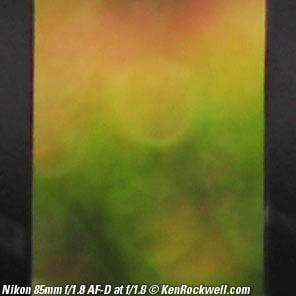 |
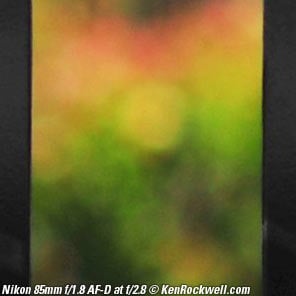 |
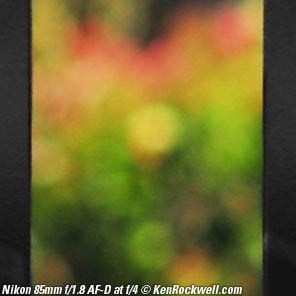 |
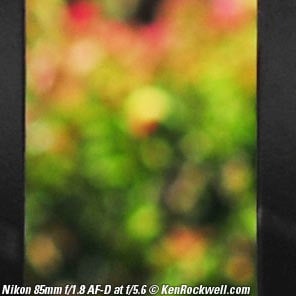 |
Color Rendition performance top
The color rendition is the same as my other Nikkor AF lenses.
Coma performance top
The Nikon 85mm f/1.8 has no coma, whoo hoo!
Coma (saggital coma flare) often causes weird smeared blobs to appear around bright points of light in the corners of fast or wide lenses at large apertures. In lenses that have it, coma goes away as stopped down.
Full-frame image, 8 seconds at f/1.8, ISO 200, Nikon D3.
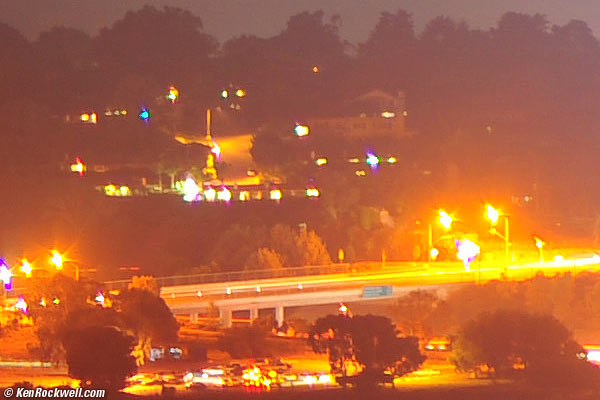
Crop at 100% magnification from lower left.
Distortion performance top
The Nikon 85mm f/1.8 AF-D has no visible or measurable distortion at any distance. Whatever it may be, it's less than what would take a factor of ±0.1 in Photoshop's lens distortion filter to correct. Bravo!
FX and Film |
||
∞ |
0.0 |
0.0 |
30' (10m) |
0.0 |
0.0 |
10' (3m) |
0.0 |
0.0 |
3' (1m) |
0.0 |
0.0 |
© 2012 KenRockwell.com. All rights reserved.
Ergonomics (handling and ease-of-use) performance top
Ergonomics are straightforward: if you don't mind moving the AF-MF switch on the camera to swap modes and keep your fingers away from the focus ring while it's autofocusing, everything else is perfect.
The 85/1.8D feels perfect. It's a precise, tough and well-built instrument.
Eyeblow performance top
The rear element of the 85mm f/1.8 AF-D moves a little as focused, but not enough to notice any air blow out of the eyepiece.
Falloff (darkened corners) performance top
Falloff on FX is visible at f/1.8 and f/2, and gone by f/2.8.
It won't be an issue at all on DX (see crop factor).
I've exaggerated this by shooting a gray field and placing these on a gray background.
Nikon 85mm f/1.8 AF-D falloff on FX and film at infinity, no correction.
© 2012 KenRockwell.com. All rights reserved.
|
Filters, use with performance top
There is no problem with vignetting, even with combinations of thick filters.
The metal filter ring never moves.
Focus Breathing performance top
Of interest mostly to cinematographers focusing back and forth between two subjects, the image size from the highly advanced rear-focusing Nikon 85mm f/1.8 AF-D doesn't vary much as focused.
If you're pulling focus through the entire range, image size is minimum at about 10 feet (3 meters), and grows slightly at infinity and at closer distances.
Ghosts performance top
As shown at Coma, there are no significant ghosts.
Hood performance top
The screw-in metal hood is included.
It's so much nicer than the plastic turd included with the Chinese 85/1.8G.
Lateral Color Fringes performance top
There are no lateral color fringes on the D3 or D7000, which corrects them automatically.
There is some spherochromatism, which is a different aberration.
Mechanics and Construction performance top
Rear, Nikon 85mm f/1.8 AF-D. enlarge.
The Nikon 85mm f/1.8 AF-D is a tough, all-metal lens encased in a plastic cover.
It's a lot tougher than the new plastic 85/1.8G.
Filter Threads
Solid metal.
Hood
Solid metal.
Hood Mount
Solid metal.
Barrel Exterior
Plastic.
Focus Ring
Solid metal; rubber covered.
Depth-of-Field Scale
Yes.
Internals
Metal.
Aperture Ring
Plastic, pained numbers.
Mount
Dull-chromed brass.
Markings
Paint.
Mounting Index
Engraved line filed with white paint.
Identity

Engraved metal identity ring.
Front ring: engraved metal, filled with white paint.
Barrel: paint.
Serial Number
Laser engraved onto bottom rear of aperture ring.
US Model Signified by
"US" prefix to serial number.
Rain seal at mount
No.
Noises When Shaken
Mild clicking from the diaphragm blades and actuation system.
Made in
Thailand since 2010.
Made in Japan 1987-2010.
Sharpness performance top
Warning 1: Image sharpness depends more on you than your lens.
Warning 2: Lens sharpness doesn't mean much to good photographers.
With those caveats, the Nikon 85mm f/1.8 AF-D is super sharp at every aperture even on the 24 MP Nikon D3X and 36 MP D800, even the first 1987 version, even out to the corners at f/1.8!
Of course diffraction limits performance at smaller apertures depending on the resolution of your camera. The 85/1.8 is so sharp that f/4 is its sharpest aperture; on the D3X and D800, diffraction makes the image, under ideal test conditions, slightly softer starting at f/5.6!
It's super-sharp on a D3X and D800 even wide-open at f/1.8 edge-to-edge, and gets even slightly sharper stopped down to f/2.8 or f/4.
To get this level of sharpness, you really have to have your technique well dialed-in. If you're out of focus, or your subject isn't flat and well-aligned to your image sensor or film plane, sloppy technique limits sharpness more than anything to do with this lens.
Diffraction means that the 85/1.8 is much softer at f/8 and smaller if you're really looking closely, as it is with all lenses. Most lenses aren't as good as this 85mm, so diffraction's degradation at smaller apertures isn't as obvious with them.
Spherochromatism performance top
Like many fast, long lenses, the Nikon 85mm f/1.8 shows some spherochromatism.
This aberration, called "color bokeh" by laymen, renders mild green color fringes around background highlights, and magenta color fringes around foreground highlights.
If you're not in perfect focus, it will put these color fringes on bright highlights. It's not the lens' fault; it's yours for not being in perfect focus.
Sunstars performance top
With its straight 9-bladed diaphragm, the Nikon 85/1/8 AF makes exquisite 18-pointed sunstars with bright points of light.
Sunstar and Rockwell, Ragged Point Resort, 19 June 2010. enlarge.
Survivability performance top
Unlike the new 85mm f/1.8 G which is mostly plastic and depends on a proprietary ultrasonic motor for its heart, this classic screw-focus AF lens has nothing to break inside of it that a good independent repairman can't fix for you 50 years from now.
The plastic on the outside of this AF and AF-D lens is simply a cover to keep it from freezing to your skin in arctic cold; the internals are metal.
Compared top
Intro Specifications Performance Compared Recommendations
Nikon 85/1.8 K, Nikon 85/2 AI-s, Nikon 85/1.4 AI-s, Nikon 85/1.8D, Nikon 85/1.4D and Vivitar 85/1.4. (enlarge; actual size at 106 DPI).
Nikon 85/1.8D, 85/1.8G, 85/1.4G and 85/1.4D. enlarge.
Nikon has made a lot of 85mm lenses in its day. In rangefinder days, it called them 8.5 cm lenses. Even my 8.5cm f/2 lens for my Nikon SP is super sharp; all Nikon's 85mm lenses are superb.
This 85/1.8 AF is optically superb, compact, well-made and handles well. There's no reason to look any further, unless you'd rather have a dinkier plastic lens in exchange for instant manual-focus override or need autofocus on Nikon's cheapest DSLRs (then get the 85mm f/1.8 G), or want the ultimate in Heavenly bokeh, for which you deserve the unmatched 85mm f/1.4 AF-S G. For the smallest size, I've always loved my 85mm f/2 AI-s.
See also:
85mm Lens Specifications Compared 23 June 2009
85mm Lens Central Sharpness Comparison 23 June 2009
85mm Lens Corner Sharpness Comparison 23 June 2009
NEW: Nikon 85mm f/1.8 G January 2012.
Recommendations top
Intro Specifications Performance Compared Recommendations
I love this lens so much I own at least two of them! I especially love the fast focus and 18-pointed sunstars I get from its 9-bladed diaphragm.
I have no love for the dinky new 85mm f/1.8 G. Why would I want to pay more for a plastic lens with a downgraded 7-bladed diaphragm?
This is a lens to get if you don't have an 80-200/2.8 zoom. The zooms tends to be almost as sharp and almost as fast, so don't ever carry both at the same time.
I strongly recommend this lens if you want a superb fast prime portrait lens or general-purpose fast, short tele at a reasonable price. It's the one fixed tele I'd grab along with a wide lens for day-to-day shooting.
If you own the 28-300mm VR, forget any fixed lenses in this range; you'll probably not ever pull out a fixed 85 if you have the zoom.
If you have a zoom and want a lens to blow-out backgrounds into smooth, soft colors at a reasonable price, shoot it at 200~300mm, and you'll get the same effect or better than an 85mm lens at f/1.8. If you want a fixed tele for blurring backgrounds at a reasonable price, get a manual-focus 135mm f/2 or 180mm f/2.8 instead. Longer focal length has much more to do with blurring backgrounds than maximum aperture.
If you want an 85mm with incredible ability to blur backgrounds and keep the subject ultrasharp, the extraordinary 85/1.4G is even better than this 85mm AF-D.
So, especially bought used, this 85mm f/1.8 is among Nikon's best lenses ever, at a very reasonable price.
If you find all the time I put into sharing all this research for free, this free website's biggest source of support is when you use these links, especially this link directly to it at Adorama, at Amazon or used at this direct link to it at eBay (see How to Win at eBay), when you get anything, regardless of the country in which you live. Thanks! Ken.
Deployment
Hint: the included HN-23 metal hood screws into the lens' 62mm threads. The front of the hood has no threads, however any of the Nikon snap-on 77mm plastic lens caps pop right on the front of the hood. If you don't change filters, you could leave the hood on all the time and use a 77mm cap!
Hint: The focus ring moves even during autofocus, so keep your fingers off it.
I'd keep a Nikon 62mm NC filter on it for protection on digital cameras, or when shooting color print film, or B&W film indoors.
I'd use a 62mm Hoya Super HMC 81A filter with Fuji Velvia 50 or other color slide film.
I'd use a Hoya 62mm yellow filter outdoors with B&W film.
More Information: Written review in Popular Photography, February 1999, page 76.
Help me help you top
I support my growing family through this website, as crazy as it might seem.
The biggest help is when you use any of these links to Adorama, Amazon, eBay, Ritz, Calumet, J&R and ScanCafe when you get anything, regardless of the country in which you live. It costs you nothing, and is this site's, and thus my family's, biggest source of support. These places have the best prices and service, which is why I've used them since before this website existed. I recommend them all personally.
If you find this page as helpful as a book you might have had to buy or a workshop you may have had to take, feel free to help me continue helping everyone.
If you've gotten your gear through one of my links or helped otherwise, you're family. It's great people like you who allow me to keep adding to this site full-time. Thanks!
If you haven't helped yet, please do, and consider helping me with a gift of $5.00.
As this page is copyrighted and formally registered, it is unlawful to make copies, especially in the form of printouts for personal use. If you wish to make a printout for personal use, you are granted one-time permission only if you PayPal me $5.00 per printout or part thereof. Thank you!
Thanks for reading!
Mr. & Mrs. Ken Rockwell, Ryan and Katie.
Home Donate New Search Gallery Reviews How-To Books Links Workshops About Contact

